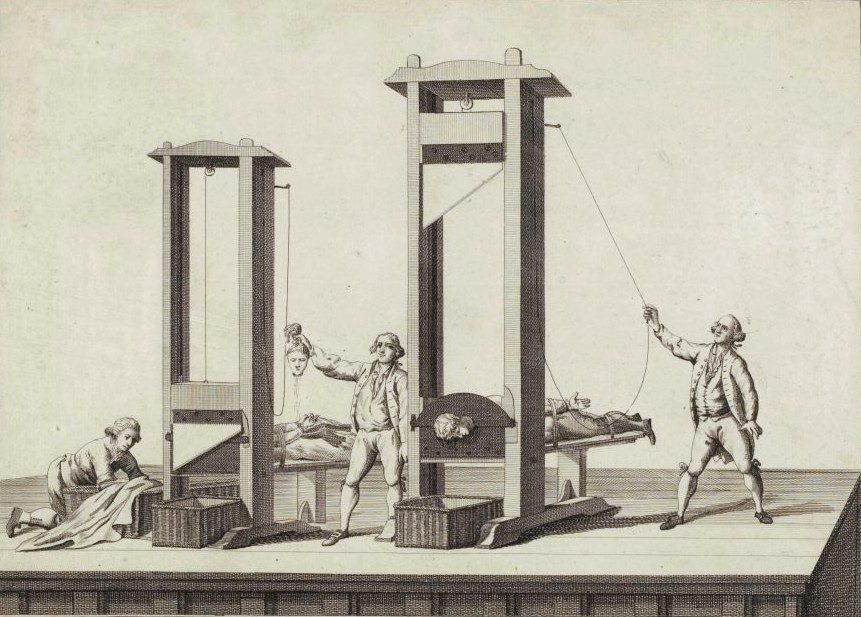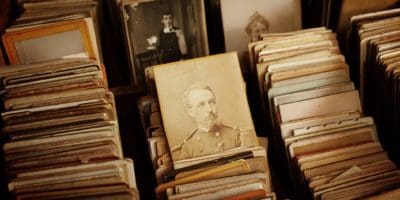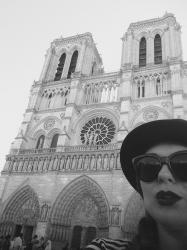15 Insane (but true) Facts About the Guillotine
*Originally written by Eve in June 2018 and updated by Arielle in November 2019, updated by Vanessa in August 2022 and Updated by Vanessa R in July 2023
The guillotine is by far one of the most gruesome methods of execution. Also known as: Madame la Guillotine, la Dame (the Lady), la Veuve (the Widow), le Rasoir National (the National Razor), and Louisette, the guillotine is synonymous with ‘the Terror’ of the French Revolution, and it continues to both horrify and fascinate us.
Some of these facts may surprise you. For instance, did you know that the famous French figure Marie Antoinette was sentenced to death and executed via guillotine blade right in the middle of Place de la Concorde?
In this article, we’re going to delve into some grisly facts about the device…
1. It was not actually invented by Dr. Joseph-Ignace Guillotin
Though his name is linked with the device, Dr. Joseph Guillotin (French doctor, politician and humanist) did not invent it rather he aided in the creation. Guillotin was actually against the death penalty, but seeing as his colleagues were not keen on abolishing it, he then advocated pain-free methods of execution. True to the founding principles of the Revolution: Liberté, Egalité et Fraternité (Liberty, Equality and Fraternity), he believed that everyone should be treated equally in life as in death.
Prior to the Revolution peasants convicted of crimes were tortured and hanged, while their aristocratic counterparts were dispatched swiftly, and mercifully, by a swordsman. Even in death peasants couldn’t get a break! The Guillotine was seen as ‘the great equalizer’ as well as the defender of Revolutionary principles.
Guillotin worked with Dr. Antoine Louis (French surgeon) and Tobias Schmidt (a German artisan and harpsichord manufacturer) to design the first prototype, and it is actually credited as being invented by Dr. Louis, hence the common other nickname Louisette.
Guillotin’s relatives were so embarrassed that their family name was associated with decapitation that they requested for the device’s name to be changed. Upon the French government’s refusal, the Guillotin family changed their own name.
2. It wasn’t the first decapitation device
Since the Middle Ages the British had been using a decapitation device dubbed the ‘Halifax Gibbet’. The first recorded use of the Halifax Gibbet was in 1286 in Halifax, England.
The gibbet differs from the guillotine in that a rope must be cut for the blade to descend. Complications arose due to the crescent shape of the blade, unlike its angled guillotine counterpart. (I don’t even want to get into the horrors that ensued with a rounded blade…. suffice it to say, angled is better for everyone concerned.) The last recorded use of the Halifax Gibbet was in 1650. The Scottish also had a similar device called the ‘Maiden’ that was first used in Edinburgh in 1564.
3. People booed after witnessing the first public guillotining
Many people turned up at Place de Grève (now place de l’Hotel de Ville, Paris) out of curiosity on April 25, 1792 to witness the first public execution using the new mechanized device. Nicolas Pelletier had been sentenced to death for theft and violently resisting arrest. The crowd was not at all impressed with the anti-climactic swiftness of the blade. In a few seconds, it was ‘game over’, and they felt cheated out of a few hours of entertainment. (Normally public executions included torture and hanging.) The crowd wasn’t won over by the ‘modern machine’ and they even booed executioner, Charles-Henri Sanson.
People were used to witnessing gruesome acts of horror that made the guillotine a humane way to go. Before the guillotine became the tool for execution, things were done differently, and much more violently (I know, it’s hard to imagine something more violent than decapitation by falling blade, but it’s true.)
As mentioned above, wealthy people were executed in less brutal ways such as hanging. Poor people and peasants who committed crimes, however, were actually tortured in some of the most horrific ways possible. Ever heard of quartering? This is when the accused is tied to the back of a horse, dragged into town, and then his limbs are tied to 4 separate horse carriages. You can imagine what happens next, and people were there to watch it all go down.
This is why people were so disappointed when they came to witness a public execution. It’s quite disturbing, but part of the entertainment was watching the accused suffer, and the guillotine prevented such suffering from occurring.
4. Guillotine earrings and toys for the kids?
During the height of the first French Revolution, executions were so frequent in Paris that they attracted large crowds. People even brought their children to witness these events, and industry popped up around the scaffolds. There were food booths and leaflets were printed listing the names of the condemned as macabre souvenirs. (Kind of like French Revolution-execution Pokémon. ‘Got to catch them all’?) A group of older ladies called ‘les Tricoteuses’ (the knitters) would spend the whole day knitting while watching the blade crash.
Some fervently patriotic ladies actually wore guillotine earrings, and miniature working guillotines were a hit with both adults and children alike.

The Nazis during the occupation of France – Courtesy of Wikimedia Commons
5. Nazis slaughtered over 16,000 people by guillotine
We normally associate the guillotine with the severe brutality of the French Revolution. 16,549 men and women were executed by the guillotine. However, did you know that the Nazis actually used the guillotine when during the 12 horrifying years they were in power? It has been claimed that the Nazis beheaded almost as many victims as during the French Reign of Terror…
Hitler ordered the guillotine as a method of execution in the 1930s, and ordered that 20 of the machines be placed in cities across Germany. According to Nazi records, the guillotine was eventually used to execute some 16,500 people between 1933 and 1945, many of them resistance fighters and political protesters.
If you thought this couldn’t get more disturbing, it does. The Nazis even charged the families of those they had imprisoned and beheaded, sending invoices to the families of the deceased.
6. It was briefly ‘banned’ from 1906 – 1909
There was a growing unease about capital punishment in French society in the early 20th century. President Armand Fallières (who was very much against capital punishment) pardoned all of those who had been previously sentenced to death, and this caused a public outcry.
The newspaper ‘Le Petit Parisien’, which was pro-capital punishment, polled their readers about the death penalty. They received 1 412 347 responses in total, and the results indicated that 74% of readers were pro-guillotine. This naturally helped the anti-abolitionist cause going into the referendum of 1908. The votes were 330 in favour of the death penalty, and 201 against. The French people and elected officials had spoken, they wanted ‘Madame la Guillotine’ back.
The Chief Executioner of France at the time, Anatole Deibler, nicknamed ‘Monsieur de Paris’ (the man from Paris), had been out of a job for three years due to the Presidential pardons. Deibler sold champagne to make a living. In 1909, he resumed his role as Chief Executioner of France until his death in 1939.
7. The last public execution in France took place in 1939
Eugen Weidmann and two other men were implicated in a serial kidnapping, robbery and murder ring. Their victims were primarily tourists visiting Paris. The subsequent trial was gruesome, sensational, and turned into a media circus. Weidmann was found guilty, and sentenced to death for his crimes. A large crowd gathered on the morning of June 17, 1939 outside of the Saint-Pierre Prison in the town of Versailles to witness the spectacle. Instead of the usual silence and solemnity, they were boisterous and quasi-hysterical. After the execution was carried out, members of the frenzied crowd launched themselves onto the blood-soaked ground in order to dab various items in it for macabre souvenirs. Adding to the scandal, it was later discovered that the execution had been secretly filmed.
Traditionally, public executions were meant to show the perils and direct consequences of disobeying the law. President Albert François Lebrun said that Weidmann’s execution had awakened the base animal instincts of the people and created a mob mentality. It was the last public execution via guillotine to take place in France.
8. The end of capital punishment in France
France’s love/ hate relationship with the guillotine ended in 1981 with the abolition of capital punishment.
The last execution using the guillotine took place on September 10, 1977. Hamida Djandoubi was charged with the torture and murder of a Élisabeth Bousquet, he was found guilty of those crimes, and was sentenced to death. The execution was carried out in the courtyard of Baumettes prison in Marseilles, and was officiated by Marcel Chevalier (France’s last executioner).
How crazy is it to think that just a little over 40 years ago people were still being executed by decapitation?
9. 7 Seconds ’til death
Perhaps the guillotine was a little ‘too good’ at its job due to the swiftness and efficacy of the blade. The head of the victim would fall into a basket at the foot of the device, whereupon the executioner would hold up the head of the victim for the crowd. There were numerous reports of facial twitches, eye and lip movements in the severed heads.
In the 1950s French doctors Piedelievre and Fournier concluded that death by guillotine was not as instantaneous as previously thought. In the following decades, research continued using rats to measure brain function after decapitation.
The conclusion is that after a swift decapitation, it will take 7 seconds before the brain ceases to function due to blood and oxygen deprivation.
10. You can actually go see the last guillotine blade in Paris
A guillotine blade that was used during the first French Revolution at Place de Grèves (now place de l’Hotel de Ville) can be viewed at the Police Museum (Musée de la Préfecture de Police), located on the third floor of an active police station in the Latin Quarter. The museum is one of Paris’ many hidden gems, and explores the history of France’s police force, capital punishment, and traces the advancement of crime detection technology.
Musée de la Préfecture de Police
Location: 4, rue de la Montagne Sainte-Geneviève – 75005 PARIS, 3rd Floor
Hours of Operation: Monday – Friday (9:30 p.m. – 5 p.m.) and the third Saturday of every month (10:30 a.m. – 5:30 p.m.)
Cost: 0
Metro: Maubert-Mutualité, line 10
Map:
11. Marie Antoinette handled the guillotine with grace while Louis XVI came close to avoiding it

Marie-Antoinette by Musée Antoine-Lécuyer from Wikimedia Commons
Although some estimates put the number at much to 40,000, the “national razor” was used to behead about 18,000 persons during the Revolution. Louis XVI was the first member of the royal family to be executed on January 12, 1793, but it was only by a slim margin (361 votes in favour to 288 votes against).
Unfortunately for him, his cousin Louis Philippe d’Orléans supported his death. On October 16, 1793, Marie Antoinette’s dying words were “I’m sorry.” This was a courteous gesture after she stepped on the executioner’s foot and not a reference to any offences against the republic.
12. Executions by guillotine were popular spectator attractions
Thousands of “enemies of the French revolution” were executed by the guillotine during the Reign of Terror in the middle of the eighteenth century. The procedure quickly transformed into high entertainment, despite several members of the public’s early complaints that the machine was too swift and clinical.
Numerous songs, jokes, and poems were written in praise of the guillotine, which attracted large crowds of spectators to the Place de la Revolution to see its gruesome operation. Visitors had the option to purchase mementoes, peruse a program that listed the victims’ names, or even stop by the neighbouring “Cabaret de la Guillotine” restaurant for a quick meal.
13. Guillotine operators were well-known in their country
As the guillotine’s notoriety increased, so did the reputations of those who used it. During the French Revolution, executioners gained a tremendous degree of reputation because of how well and rapidly they could plan several beheadings.
Family businesses frequently ran the job. From 1792 through 1847, many generations of the renowned Sanson family carried out hundreds of executions, including that of King Louis XVI, Marie Antoinette, and other notable individuals. Louis and Anatole Deibler, a father and son team whose total career spanned from 1879 to 1939, held the position of chief headsman during the 19th and 20th centuries.
The Sansons and Deiblers were frequently mentioned in street chants, and the outfits they wore while standing on the scaffold were known to influence current fashions. The criminal underworld also has a pathological obsession with executioners. Some claim that terrible messages like “My Head Goes To Deibler” would be tattooed on the bodies of hoods and other criminals.
14. Brutal research was done on the heads of condemned people by scientists

Guillotine by Milky from Wikimedia Commons
Whether the heads of the guillotined remained aware after being severed was a subject of much debate from the very beginning of its use. When an assistant executioner smacked one of his victims in the face and witnesses said they saw the victim’s cheeks flush with rage, the controversy reached new heights in 1793.
In order to see if a child killer who had been executed by the guillotine would regain consciousness and speak, a doctor by the name of Dassy de Lignieres even injected blood into the victim’s brain. The gruesome tests came to an end in the 20th century, but investigations on rats have subsequently revealed that brain activity may persist for up to four seconds after decapitation.
15. Various subjects were used in the guillotine tests
Before the French Revolution, devices like the guillotine were in use. Nevertheless, the famed system was being fine-tuned throughout this terrible Parisian time.
The guillotine was tested on a variety of people in order to prevent public humiliation on behalf of the government. Live lambs and calves and then human cadavers were the main subjects of study beginning in 1792. Three more human corpses were chosen because they were physically strong males who had not died in a frail or weak state, ideally from an accident or abrupt sickness, after it was determined that the testing had not been up to pace.
These tests, which were initially designed to test the guillotine’s accuracy, also provided medical experts with important insights into disturbance-based research. Medical professionals were particularly curious to know whether a certain organ performed a crucial job. So they utilized subtractive reasoning to get to a conclusion.
We hope you enjoyed reading some of these grisly yet interesting facts about a device that represents France during a dark period of the past. It’s an interesting juxtaposition when we think about the way we see France now, and how we associate romance, light, beauty, and charm instead of death and gore as it was viewed during the French Revolution.
See you soon in Paris! Don’t hesitate to contact us if you need further information about anything! You can also leave a comment and we will happy to answer you.
Are you in Paris now or coming soon? Discover Walks run innovative and fun walking tours in Paris. Montmartre, The Latin Quarter, The Marais… we go everywhere!
Famous French People Who Died by Guillotine
1. Marie Antoinette

After Jean-Baptiste André Gautier-Dagoty, Public domain, via Wikimedia Commons
An uprising against the monarchy began on July 14, 1789, also known as “Bastille Day,” when a mob stormed the Bastille prison and stole the weapons and ammunition they needed. The royal family was brought to Paris, where they practically lived under house arrest, on October 6, of that same year, after they entered Versailles. The French Republic came into being and the monarchy was formally abolished in 1792.
Marie Antoinette was put on trial the following year, in 1793, for treason and several other offences, including adding to the national debt of France by leading a lavish lifestyle. She spent her last days in a miserable prison because the jury had found her guilty and because it was thought to be too elegant for the queen. Four years after being brought to Paris, she died at the guillotine on October 16, 1793.
2. King Louis XVI
The French monarchy, which came to an end with King Louis XVI, was founded on the idea of the divine right of kings, which essentially held that God had appointed a king and that he was therefore above the law. Sadly, King Louis XVI is known for his political incompetence, which may have contributed to the French Revolution, even though he was not required to be competent to occupy the office.
In May 1789, King called a meeting of the Estates-General, a group of nobles and commoners, to discuss the country’s financial difficulties. The members of the meeting decided to draught a new constitution that would restrict the authority of the “divinely instated” ruler, thus it didn’t go well for the king. The monarch was powerless to stop the coming revolution since he was indecisive and incapable of handling issues. He was transferred to Paris, where the new National Assembly found him guilty of treason, along with his wife and family. On January 21, 1793, the king was executed by hanging.
3. Princess Elisabeth
Louis XVI’s sister, Princess Elisabeth, was a royal. She had only turned a year old when he took the throne, and she stayed close to him and the rest of her family throughout his reign. She never married, possibly because she was very close to her brother and did not want to form a foreign bond through marriage, which would definitely separate her from her family. She had a reputation for being deeply religious and adopted a conservative royalist political stance, likely because of the close connection between religion and the monarchy due to the concept of monarchs’ divine right.
Robespierre had her detained and brought before the Revolutionary Tribunal in 1794 despite the fact that she was not viewed as a threat; the king and queen had already been put to death, so her fate had already been decided. She was put to death at the guillotine after being accused of treason for aiding the royal family in their attempt to flee.
Planning a trip to Paris ? Get ready !
These are Amazon’s best-selling travel products that you may need for coming to Paris.
Bookstore
- The best travel book : Rick Steves – Paris 2023 – Learn more here
- Fodor’s Paris 2024 – Learn more here
Travel Gear
- Venture Pal Lightweight Backpack – Learn more here
- Samsonite Winfield 2 28″ Luggage – Learn more here
- Swig Savvy’s Stainless Steel Insulated Water Bottle – Learn more here
Check Amazon’s best-seller list for the most popular travel accessories. We sometimes read this list just to find out what new travel products people are buying.


















